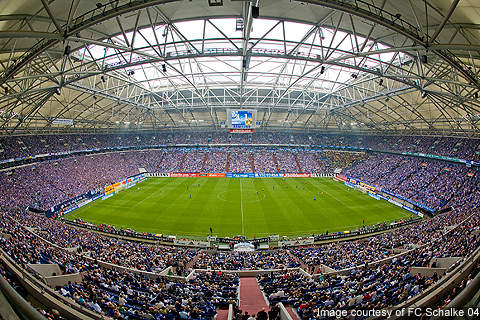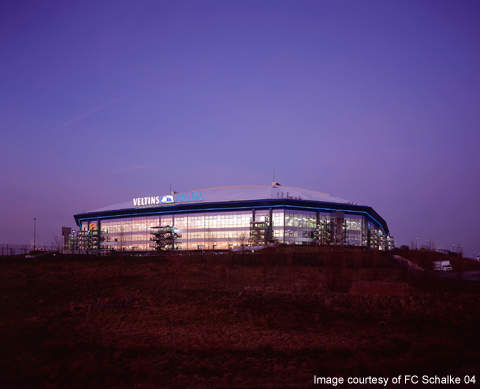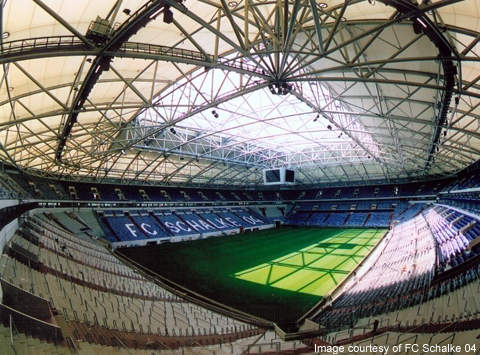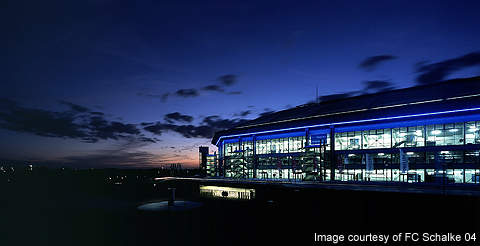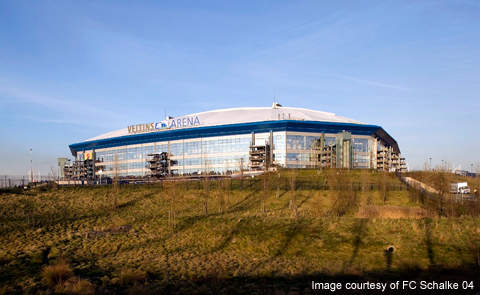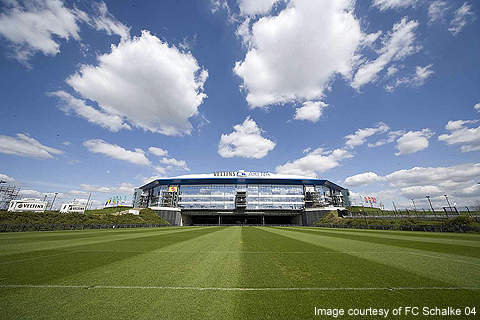Veltins Arena, also known as the Schalke Arena, is a multi-purpose stadium located in the Erle borough, north of Gelsenkirchen, Germany. The retractable roof and sliding pitch of the stadium make it a multi-purpose arena. Hentrich-Petschnigg & Partner (HPP) was the architect of the stadium.
The soccer stadium is the home ground of the famous football club Schalke 04, who also own and operate it. Opened in August 2001, the stadium was previously called Arena AufSchalke.
After hosting five World Cup matches in 2006, Veltins Arena was named the FIFA World Cup Stadium. It also hosted the UEFA Champions League final in 2004 and received the international IOC / IAKS AWARD Special Distinction award for its architecture in 2005.
Schalke 04 started plans to build a new football ground stadium in 1996. Arena AufSchalke was built in the Berger Field to replace the age-old Park Stadium, which had problems related to mining subsidence. The Park Stadium was built in 1973.
Veltins Arena required an investment of €143m, all of which was privately financed. The stadium has a seating capacity of about 54,142 and 61,673, including the terracing.
Veltins Arena design
Veltins Arena is designed to suit multifunctional events along with its main function as the soccer stadium. The stadium is of rectangular shape with bevel corners. The arena is created to be operational in all weather conditions. The movable roof covering the entire stadium can be opened in two parts from the centre. It can be closed or opened within 30 minutes based on the event and weather conditions.
The playing field of the stadium is innovatively designed with a sliding grass pitch to avoid delays in arranging high-quality turf during the events. The slide-out pitch is moved in during the soccer matches and laid outside on the south side of the stadium to receive natural light and air. It can be moved in or out of the stadium in about four hours.
Veltins Arena structure
The Veltins Arena has a 225m long, 187m wide and 53.5m tall truss roof that spans the entire arena. The translucent Teflon-coated, glass-fibre fabric roof is supported by a rectangular truss, which is connected to the main building through 24 steel pylons. The inner layer of the roof is coated with additional Teflon, which acts as a sound absorber.
The concrete structure of the stadium is divided into 15 separate segments. Each segment has its own stability system and foundation, and is connected by 150mm-wide expansion joints. The roof is founded by 660 piles at a depth of about 22m to avoid the risk of subsidence. It is a 3,700t steel space frame construction with fixed and moveable sections, which spans freely over a length of 225m and a width of 186m, and provides clear views. The 4,060t truss is about 13.5m high. The steel valley cables on the fabric tighten it between the supporting trusses for stability.
The convertible roof is also supported by 26 hinged edge columns with ball-bearing edges that move in three dimensions. Four vertical edge frames from the centre of the straight-stand section provide stability to the roof.
The sliding pitch of Veltins Arena is laid inside a reinforced concrete container containing a special soil mixture. The 400mm-deep substructure, measuring 119m x 79m and weighing 11,000t, was built using 400 precast concrete feet of 700mm-high each.
The tray rests on sliding soles comprising a rubber layer, steel plate and Teflon sole, which slide over 16 resin-coated steel slide rails. The rails are built in a 350mm-deep reinforced concrete slab. The sliding is built over a 320m-long secondary foundation concrete slab, which floats on a continuous slide film to avoid shrinkage. A 2m-deep lateral ditch below the foundation slab enables inspection and maintenance.
The steel bridge structure of the south stand forms the upper tier of the spectator bowl and provides a gap for the pitch movement. The lower tier of the south stand is movable by about 16m below the upper tier and provides additional space for a stage. The concourse floors are made of precast hollow concrete.
The glass façade is topped by an expressive huge gutter with external staircases and two-level concourses.
Arena construction
The site of the arena lies about 800m above a coal mine, which was in use until 2000. The main axis of the arena was aligned to a northeast-southwest direction, in parallel with the mines, to avoid risks from two disused coal shafts. The foundation of the stadium used 600,000m3 of packed slag and cast concrete to support the four main stands.
The construction of the stadium began in 1998 and was completed in 2001. HBM Stadien- und Sportstättenbau was the lead contractor, while HBG Engineering was the structural engineer.
Veltins Arena facilities
Veltins Arena has 72 VIP lounges, business areas and a centrally suspended scoreboard. It has several food and catering facilities, which include 50 grilling stations, 15 small restaurants and 35 cafés. Germany’s longest 5km-long beer-line, connecting the catering areas, can supply about 52,000l of beer per match day.
The arena can host exhibitions, fairs, concerts, opera, indoor and equestrian sports and motor trials. The stadium also has a multi-faith chapel for religious gatherings.

